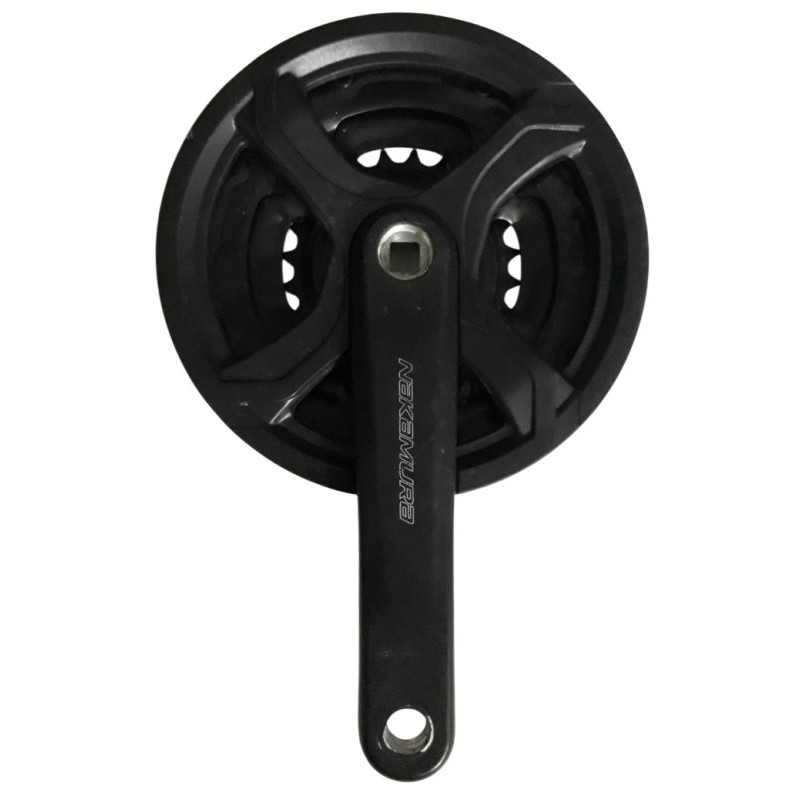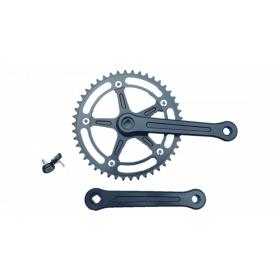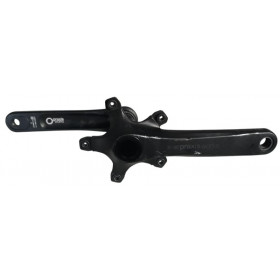 zoom_in
zoom_in
Right crank Nakamura
- Used
€9.99 VAT included
Everything you need to know about the right crank arm on a Nakamura triple chainring crankset: features and specifications
The right crank arm plays a vital role in the overall performance of your bike’s transmission system. On a Nakamura triple chainring crankset, it connects the rider’s pedaling power to the crank spindle, allowing the chain to rotate and drive the bike forward. Here’s a closer look at its features and what makes it essential for smooth riding.
What is the right crank arm on a Nakamura crankset ?
On a triple crankset, the right crank arm is the part that holds the chainrings (typically 22, 32, and 42 teeth) and onto which the right pedal is mounted. It transmits the pedaling force to the bottom bracket spindle, rotating the chainrings and propelling the bike chain. Nakamura, a brand well-known through Intersport retail stores, designs its cranksets to be durable, versatile, and compatible with a wide range of MTBs, hybrid bikes, and trekking bikes.
Technical features of the right crank arm – Nakamura triple chainring
-
Material: Usually forged aluminum for a balance of strength and lightness. Entry-level models may use steel.
-
Crank arm length: Often 170 mm or 175 mm, depending on bike size and rider leg length.
-
Chainring mounting: 4- or 5-arm spider depending on the model, with a BCD (Bolt Circle Diameter) compatible with Nakamura or Shimano/Suntour-style chainrings.
-
Chainrings: 3 chainrings attached to the crank arm, offering a wide gear range, ideal for both road and off-road use.
-
Spindle type: Square taper (JIS standard) or octalink for older models; newer Nakamura cranksets may be compatible with Hollowtech II or ISIS bottom brackets.
Specificities of the Nakamura triple crankset
The Nakamura crankset with triple chainrings is designed for smooth pedaling, whether climbing steep trails or cruising on paved paths. Its main advantage lies in the versatility of its drivetrain, thanks to the three chainrings that offer a wide gear ratio. It’s ideal for beginner or regular cyclists who want comfort and adaptability across mixed terrains.
When and why to replace the right crank arm ?
Over time, the right crank arm can become bent, cracked, or develop a stripped pedal thread. In such cases, replacement is necessary to maintain a smooth drivetrain and avoid damaging other components.
Signs that it’s time to replace your crank arm:
-
Unusual play while pedaling
-
Difficulty keeping the chain aligned
-
Pedal becomes loose or unscrews frequently
-
Excessive wear on the integrated chainrings
Compatibility and replacement tips
The replacement crank arm must be compatible with the existing bottom bracket spindle. It’s best to choose an original part or a replacement arm compatible with Nakamura triple cranksets, ensuring:
-
Correct spindle interface (square taper, octalink, etc.)
-
Proper crank arm length
-
Matching chainring mounting system
Final thoughts
The right crank arm of a Nakamura triple crankset is more than just a mechanical lever — it’s a core component of your bike transmission system. It ensures efficient power transfer, smooth rotation, and long-term performance. Taking care of it or replacing it at the right time helps you maintain a reliable, quiet, and responsive drivetrain, no matter where the road takes you.





